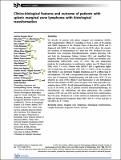Por favor, use este identificador para citar o enlazar a este item:
http://hdl.handle.net/10261/282805COMPARTIR / EXPORTAR:
 SHARE SHARE
 CORE
BASE CORE
BASE
|
|
| Visualizar otros formatos: MARC | Dublin Core | RDF | ORE | MODS | METS | DIDL | DATACITE | |

| Título: | Clinico-biological features and outcome of patients with splenic marginal zone lymphoma with histological transformation |
Autor: | Bastidas-Mora, Gabriela; Beà, Silvia; Navarro, Alba; Gine, Eva; Costa, Dolors; Delgado, Julio; Baumann, Tycho; Magnano, Laura; Rivas-Delgado, Alfredo; Villamor, Neus; Colomer, Dolors; Lopez-Guerra, Mónica; Rozman, María; Balagué, Olga; Martínez, Daniel; Baptista, Maria Joao; Escoda, Lourdes; Alcoceba, Miguel; Blanes, Margarita; Climent, Fina; Campo, Elías; Wotherspoon, Andrew; López-Guillermo, Armando; Matutes, Estella | Palabras clave: | Splenic marginal zone lymphoma Histological transformation Complex karyotype Prognostic factors Survival |
Fecha de publicación: | ene-2022 | Editor: | John Wiley & Sons | Citación: | British Journal of Haematology 196(1): 146-155 (2022) | Resumen: | We describe 36 patients with splenic marginal zone lymphoma (SMZL) with transformation (SMZL-T), including 15 from a series of 84 patients with SMZL diagnosed at the Hospital Clinic of Barcelona (HCB) and 21 diagnosed with SMZL-T in other centres. In the HCB cohort, the cumulative incidence of transformation at 5 years was 15%. Predictors for transformation were cytopenias, hypoalbuminaemia, complex karyotype (CK) and both the Intergruppo Italiano Linfomi (ILL) and simplified Haemoglobin, Platelet count, lactate dehydrogenase (LDH) and extrahilar Lymphadenopathy (HPLL)/ABC scores (P < 0·05). The only independent predictor for transformation in multivariate analysis was CK [hazard ratio (HR) 4·025, P = 0·05]. Patients with SMZL-T had a significantly higher risk of death than the remainder (HR 3·89, P < 0·001). Of the 36 patients with SMZL-T, one developed Hodgkin lymphoma and 35 a diffuse large B-cell lymphoma, 71% with a non-germinal centre phenotype. The main features were B symptoms, lymphadenopathy, and high serum LDH. CK was observed in 12/22 (55%) SMZL-T and fluorescence in situ hybridisation detected abnormalities of MYC proto-oncogene, basic helix-loop-helix transcription factor (MYC), B-cell leukaemia/lymphoma 2 (BCL2) and/or BCL6 in six of 14 (43%). In all, 21 patients received immunochemotherapy, six chemotherapy, one radiotherapy and three splenectomy. The complete response (CR) rate was 61% and the median survival from transformation was 4·92 years. Predictors for a worse survival in multivariate analysis were high-risk International Prognostic Index (HR 5·294, P = 0·016) and lack of CR (HR 2·67, P < 0·001). | Versión del editor: | http://dx.doi.org/10.1111/bjh.17815 | URI: | http://hdl.handle.net/10261/282805 | DOI: | 10.1111/bjh.17815 | Identificadores: | doi: 10.1111/bjh.17815 issn: 0007-1048 e-issn: 1365-2141 |
| Aparece en las colecciones: | (IBMCC) Artículos |
Ficheros en este ítem:
| Fichero | Descripción | Tamaño | Formato | |
|---|---|---|---|---|
| Clinico-biological features_Bastidas_PV_Art2022.pdf | 502,87 kB | Adobe PDF |  Visualizar/Abrir |
CORE Recommender
SCOPUSTM
Citations
14
checked on 24-abr-2024
WEB OF SCIENCETM
Citations
14
checked on 21-feb-2024
Page view(s)
49
checked on 29-abr-2024
Download(s)
37
checked on 29-abr-2024
Google ScholarTM
Check
Altmetric
Altmetric
Este item está licenciado bajo una Licencia Creative Commons

